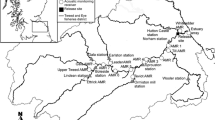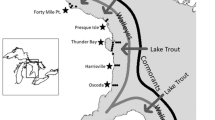Abstract
The river Ingdalselva, which drains to the Trondheims fjord, has no local salmon population due to an impassable waterfall 500 m upstream from the outlet. In the period 1994–97, a total of 31 mature Atlantic salmon (19 females and 12 males) from the rivers Orkla (1994–96) and Vigda (1997) were radio-tagged and released in the river Ingdalselva before spawning. The main goal of the project was to find out whether the fish would stay and spawn in the river, and if the observations during the spawning period could be used to indicate where spawning had taken place. Some fish left the river shortly after release, but 77% of the fish stayed in the river during the spawning period in October. Most of the females (74%) spawned in the river, including multi-sea winter salmon of approximately 10 kg. Some fish remained at the site of the release, while others migrated downstream to hiding places where they stayed until spawning. Long distance upstream migrations were not observed. The observations of the fish during the spawning period were used to identify spawning areas. Electrofishing for salmon fry in the spawning areas the following year in all cases produced fry, and in two of the years salmon fry were also found in areas where no spawning activity had been registered. Radio-tracking was an efficient method for determining whether transplanted salmon would remain in a `new'n river during the spawning season and for locating spawning areas, particularly when the fish were tracked daily.
Similar content being viewed by others
References
Bagliniére, J. L., G. Maisse & A. Nihourn, 1990. Migratory and reproductive behaviour of female adult Atlantic salmon, Salmo salar L. in a spawning stream. J. Fish Biol. 36: 511-520.
Beall, E., J. Dumas, D. Claireaux, L. Barriere & C. Marty, 1994. Dispersal patterns and survival of Atlantic salmon (Salmo salar L.) juveniles in a nursery stream. Ices J. of mar. Sci. 51 (1): 1-9.
Belding, D. L., 1934. The spawning habits of the Atlantic salmon. Trans. am. Fish. Soc. 64: 211-218.
Berg, M., 1986. History of the Norwegian Salmon and Freshwater Fishery. University Publishing House, Oslo. 162 pp (in Norwegian).
Bohlin, T., S. Hamrin, T. G. Heggberget, G. Rasmussen & S. J. Saltveit, 1989. Electrofishing-theory and practice with special emphasis on salmonids. Hydrobiologia 173: 9-43.
Coutirier, C. Y., L. Clarce & M. Sutterlin, 1986. Identification of spawning areas of two forms of Atlantic salmon (Salmo salar L.) inhabiting the same watershed. Fish. Res. 4: 131-144.
Crisp, D. T., 1995. Dispersal and growth rate of 0-group salmon (Salmo salar L.) from point-stocking together with some information from scatter-stocking. Ecol. Freshwat. Fish 4: 1-8.
Cronin, M. A., W. J. Spearman, R. L. Wilmoz, J. C. Patton & J. W. Bickham, 1993. Mitochondrial DNA variation in chinook (Oncorhynchus tshawytscha) and chum salmon (O. keta) detected by restriction enzyme analysis of polymerase chain reaction (PCR) products. Can. J. Fish. aquat. Sci. 50: 708-715.
Egglishaw, H. J & P. E. Shackley, 1973. An experiment on faster growth of salmon, Salmo salar (L.) in a Scottish stream. J. Fish Biol. 5: 197-204.
Egglishaw, H. J & P. E. Shackley, 1977. Growth, survival and production of juvenile salmon and trout in a Scottish stream, 1966-75. J. Fish Biol. 11: 647-672.
Fjellheim, A. & B. O. Johnsen, 2001. Experiences from stocking salmonid fry and fingerlings in Norway. Nordic J. Freshwat. Res. 75: 20-36.
Fleming, I. A., 1996. Reproductive strategies of Atlantic salmon: ecology and evolution. Rev. Fish Biol. Fish. 6: 379-416.
Fleming, I. A., 1998. Pattern and variability in the breeding system of Atlantic salmon (Salmo salar), with comparisons to other salmonids. Can. J. Fish. aquat. Sci. 55 (Suppl. 1): 59-76.
Fleming, I. A., B. Jonsson, M. R. Gross & A. Lamberg, 1996. An experimental study of the reproductive behaviour and success of farmed and wild Atlantic salmon (Salmo salar). J. appl. Ecol. 33: 893-905.
Fleming, I. A., A. Lamberg & B. Jonsson, 1997. Effects of early experience on the reproductive performance of Atlantic salmon. Behav. Ecol. 8: 470-480.
Gee, A. S., N. J. Milner & R. J. Hemsworth, 1978. The production of juvenile Atlantic salmon, Salmo salar in the upper Wye, Wales. J. Fish Biol. 13: 439-451.
Hawkins, A. D. & G. W. Smith, 1986. Radio-tracking observations on Atlantic salmon ascending the Aberdeenshire Dee. Scott. Fish. Res. Rep. 36: 1-24.
Heggberget, T. G., L. P. Hansen & T. F. Næsje, 1988. Within river spawning migration of Atlantic salmon (Salmo salar). Can. J. Fish. aquat. Sci. 10: 1691-1698.
Johnsen, B. O., F. Økland, A. Lamberg, E. B. Thorstad & A. J. Jensen, 1996. The use of radiotelemetry for identifying migratory behaviour in Atlantic salmon in the Sandsfjord system and in the river Suldalslågen in 1995. NINA Oppdragsmelding 421: 1-44 (in Norwegian with English abstract).
Johnsen, B. O., A. J. Jensen, J. I. Koksvik & H. Reinertsen, 1997. Production of Atantic salmon smolts based on stocking of fry in lakes. Water chemistry, plankton, bottom fauna and fish in Lakes Øvre and Nedre Mosvasstjern in the Vefsna watercourse 1986-94. NINA Oppdragsmelding 499: 1-55 (in Norwegian with English abstract).
Jones, J. W., 1959. The Salmon. London, Collins, 192 pp.
Jones, J. W. & J. N. Ball, 1954. The spawning behaviour of brown trout and salmon. Br. J. Anim. Behav. 2: 103-114.
Kennedy, G. J. A., 1982. Factors affecting the survival and distribution of salmon (Salmo salar L.) stocked in upland trout (Salmo trutta L.) streams in Northern Ireland. EIFAC Tech. Pap. 42(1): 227-242.
Kocik, J. F. & C. Paola Ferreri, 1998. Juvenile production variation in salmonids: population dynamics, habitat, and the role of spatial relationships. Can. J. Fish. aquat. Sci. 55 (Suppl. I): 191-200.
Mellas, E. J. & J. M. Haynes, 1985. Swimming performance and behaviour of rainbow trout (Salmo gairdneri) and white perch (Morone americana): effect of attaching telemetry transmitters. Can. J. Fish. aquat. Sci. 42: 488-493.
Mortensen, E., 1977. Population survival, growth and production of trout, Salmo trutta in a small Danish stream. Oikos 28: 9-15.
Nielsen, E. E., M. M. Hansen & V. Loeschcke, 1996. Genetic structure of European populations of Salmo salar L. (Atlantic salmon) inferred from mitochondrial DNA. Heredity 77: 351-358.
Økland, F., A. Lamberg, T. G. Heggberget, I. A. Fleming & R. S. McKinley, 1996. Identification of spawning behaviour in Atlantic salmon (Salmo salar L.) by radiotelemetry. In Baras, E. & J. C. Philippart (eds), Underwater Biotelemetry. Proceedings of the First Conference and Worskshop on Fish Telemetry in Europe: 35-46.
Raddum, G. G. & A. Fjellheim, 1995. Artificial deposition of eggs of Atlantic salmon (Salmo salar L.) in a regulated Norwegian river: Hatching, dispersal and growth of the fry. Regulated rivers: Res. Manage. 10: 169-180.
Rasch, H., 1852. On artificial breeding of fish and on breeding of bees. Supplement to Folkevennen 1852, 2: 1-54. Kristiania (in Norwegian).
Thorstad, E. B., 1995. Migration-and activity pattern in escaped farmed salmon and wild salmon (Salmo salar) in the river Namsen before, during and after spawning. Cand. Sci. thesis. University of Trondheim, 39 pp (in Norwegian).
Thorstad, E. B., F. Økland, T. G. Heggberget & E. Sølsnæs, 2000. Reestablishment of Atlantic salmon (Salmo salar L.) and sea trout (Salmo trutta L.) after rotenone treatment of a Gyrodactylus infected river. In Moore, A. & I. A. Russel, I.A. (eds), Advances in Fish Telemetry. Centre for Environment, Fisheries and Aquaculture Science, Lowestoft Laboratory, UK: 175-184.
Webb, J. H. & A. D. Hawkins, 1989. The movement and spawning behaviour of adult salmon in the Girnock Burn, a tributary of the Aberdeenshire Dee, 1986. Scott. Fish. Res. Rep. 40: 1-42.
Zippin, C., 1958. The removal method of population estimation. J. Wildlife Manage. 22: 82-90.
Author information
Authors and Affiliations
Rights and permissions
About this article
Cite this article
Johnsen, B.O., Hvidsten, N.A. Use of radio telemetry and electrofishing to assess spawning by transplanted Atlantic salmon. Hydrobiologia 483, 13–21 (2002). https://doi.org/10.1023/A:1021334318724
Issue Date:
DOI: https://doi.org/10.1023/A:1021334318724




